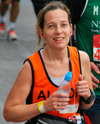Treatment & procedures by Mr Michael Gaunt MD (Dist), MA Cantab, FRCS
Treatment for sports related vascular conditions including varicose veins, hernias and fascial compartment syndrome.
Varicose Veins
Varicose veins are not commonly thought of as a condition that can affect sporting performance but they can. Veins are responsible for removing the waste products of muscle metabolism, such as lactic acid, out of the legs. When veins are not working properly the waste products are not cleared efficiently and build up in the muscles impairing function. Varicose veins are veins that are not working properly and also impair the function of the normal veins in the legs. Treating varicose veins immediately improves the venous function of the leg, improves the clearance of toxic waste products and improves performance.

Many of my sporting patients have testified to this improvement. Alison Cronk was struggling with her training for a 10k race. Her legs felt heavy while running and took a long time to recover after training. After her varicose vein laser surgery she not only completed her 10k race but went on to complete the London marathon in 2011.
Thomas Reed is a keen cyclist who enjoyed long rides together with his cycle club friends finishing with a big hill climb. Thomas found that he could not keep up with the pack cycling up the hill and had to drop back before the summit. Following laser surgery under local anaesthetic to correct his varicose veins he found that not only could he keep up with the pack all the way to the top of the hill but also cycle strongly off the top, much to the amazement of the other cyclists.
Sportman’s Groin & hernia
In my 33 years as a doctor I have spent 30 of them as a surgeon. One of the first operations I learnt to perform was a hernia repair. Over the years I have performed many thousands of hernia repairs giving me a huge experience in this area.
Sportman’s groin is a specialised area which requires a different approach from the standard management of inguinal hernia. Indeed, many sportsmen, and women, may not have a hernia at all.
There are a number of musculoskeletal problems which can cause this syndrome which requires careful assessment in conjunction with a sports specialist using ultrasound and MRI scans to delineate the pathology and decide the correct surgical approach.
I have treated many professional footballers, international athletes and rowers and the results have been excellent allowing them to return to full performance.
Compartment syndrome is a condition, which if left untreated, can ruin sporting careers and prevent many people’s enjoyment of sport.
What is Fascial Compartment Syndrome?
All the muscles of the arms and legs are surrounded and divided into compartments by fibrous envelopes. The purpose of these envelopes is to allow groups of muscles with similar functions to work together. However, with exercise and training, muscles grow bigger and during exercise muscles swell.
In most people, as the muscles grow and swell, the fascial envelopes stretch and the pressure within the compartments stays constant. However, in sufferers of the condition, the fascial envelopes are more rigid and do not stretch and as the muscles swell during exercise the pressure within the compartments increases. This pressure increase can reduce the blood supply to the muscles and also affect the nerves that run through the compartments.
Runners find that their feet can go numb and they cannot feel the foot striking the ground. They may hear the foot slapping on the ground. This severely affects athletic performance as the only solution is to stop and let the muscle swelling subside and that is the end of your race. In rowers this can affect either the arms or the legs.

Ian Williamson was a national standard middle distance runner but when he came to see me his condition had deteriorated to such an extent that he was having difficulty walking down the street despite being operated on by another surgeon. Ian had a severe and complex form of compartment syndrome affecting all four compartments of both legs. After several fasciotomy operations Ian has returned to competing at the highest level.







